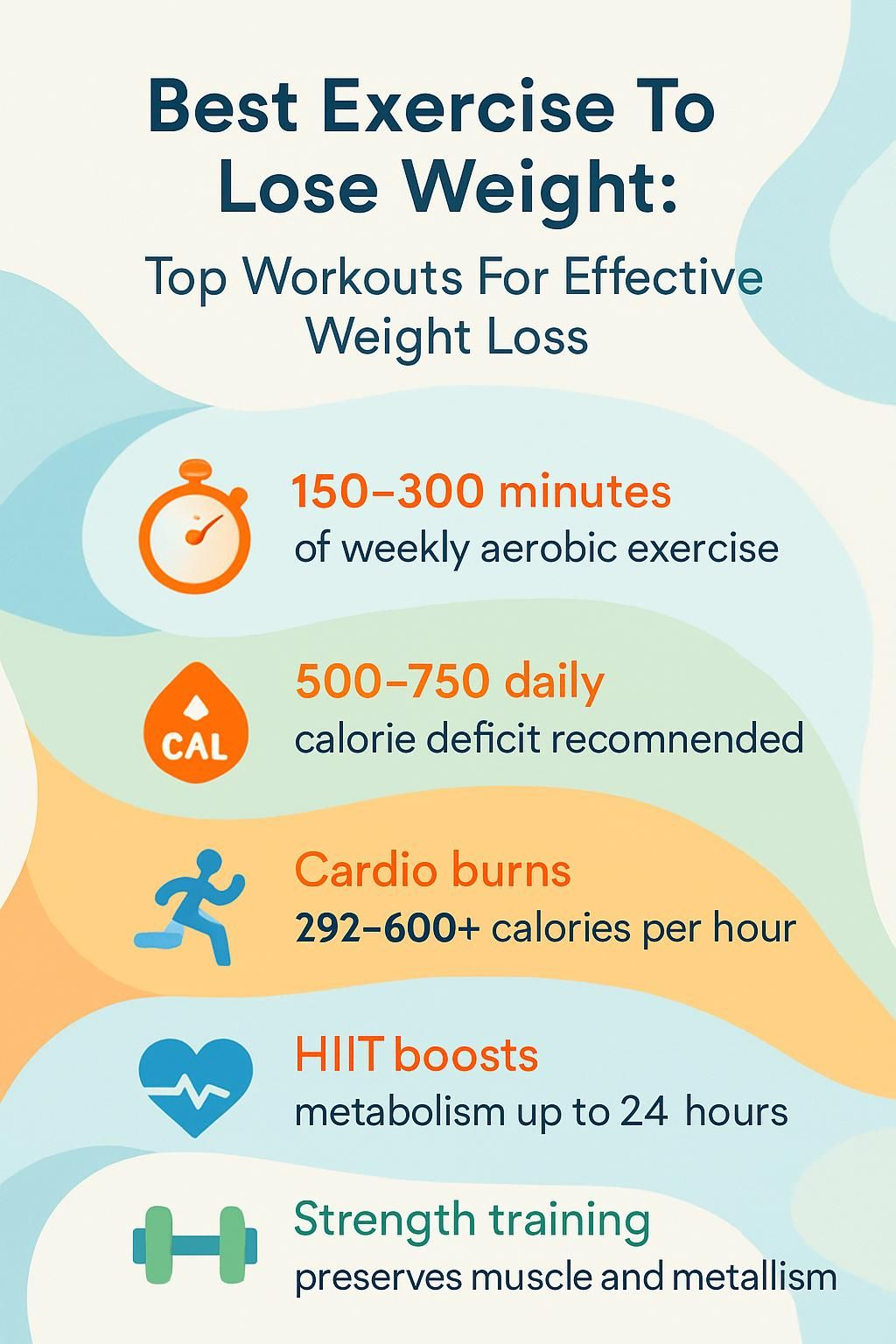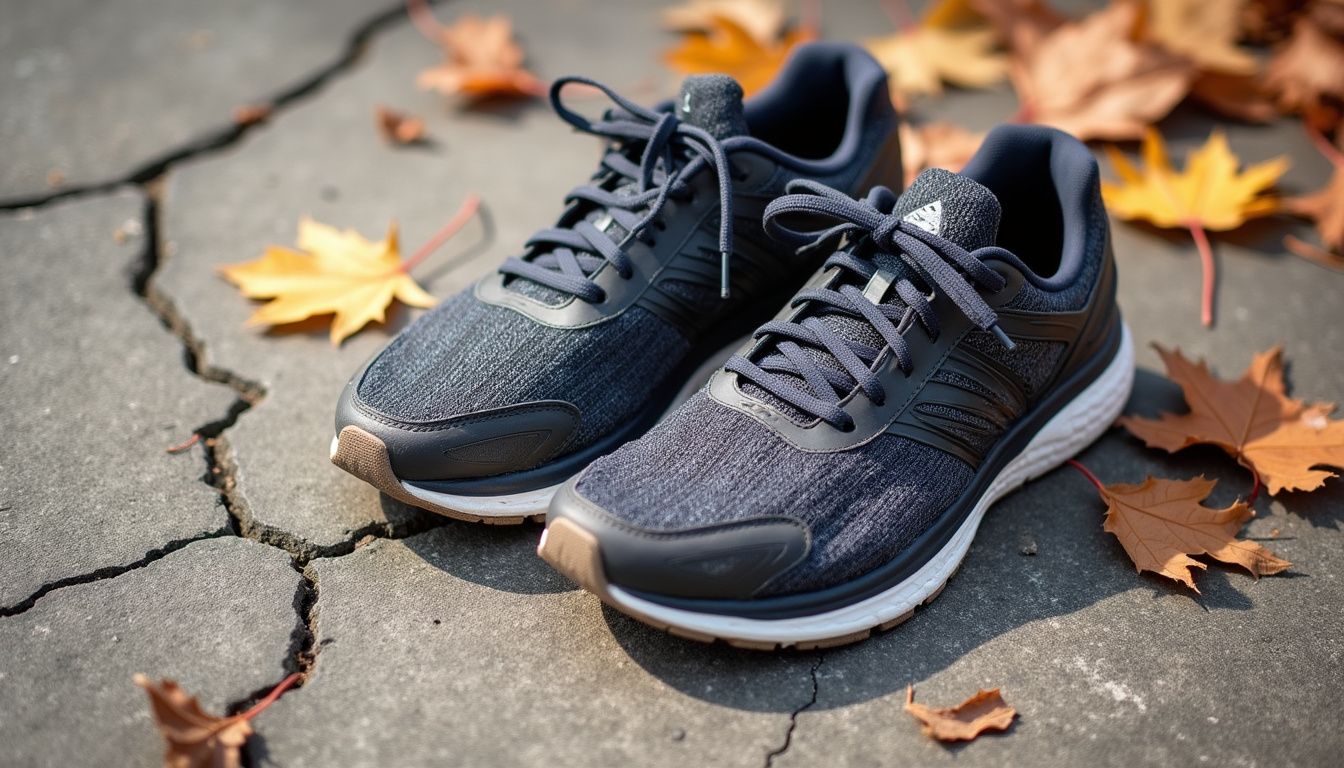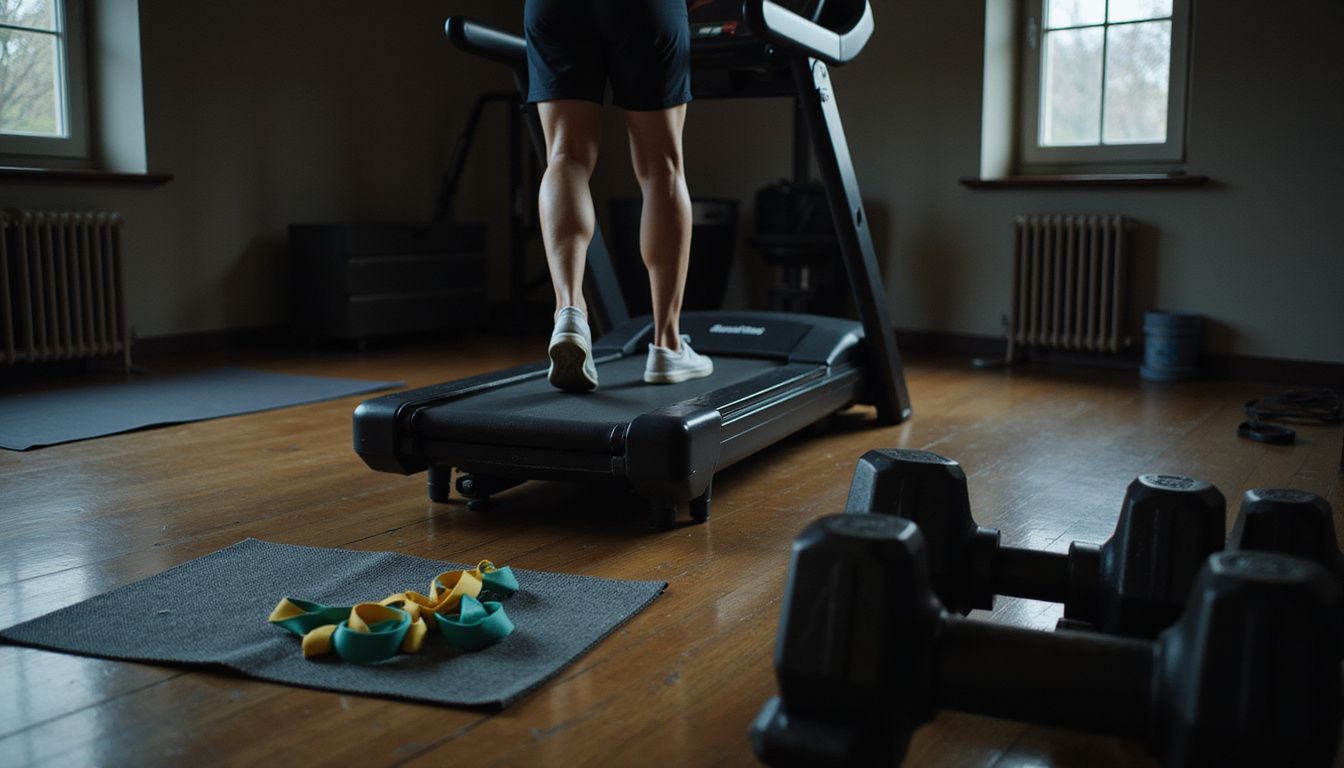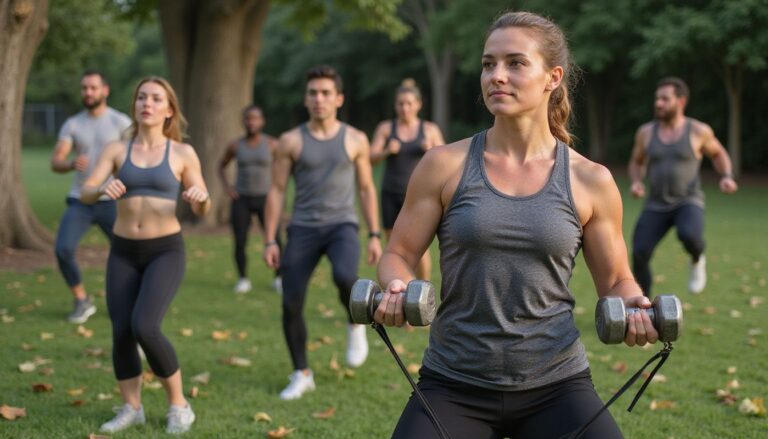Best Exercise To Lose Weight: Top Workouts For Effective Weight Loss
Our Nutrition Assistant AI Suite will transform your body. You will lose fat, get toned, and build muscle. Gain confidence and optimal health.
You work hard yet the scale hardly moves. That can feel discouraging. Exercise paired with a healthy diet is the most reliable way to drive steady weight loss. Most adults do best with 150 to 300 minutes of moderate activity each week plus a calorie deficit. This guide highlights the best exercises for weight loss, the calories they burn, and how to fit them into real life.
You will see that small, consistent changes add up. Pick a starting point today and build from there.
Health note: talk with your clinician before starting a new workout plan if you have medical conditions, injuries, or concerns.
Key Takeaways
- Combining 150 to 300 minutes of moderate aerobic exercise each week with a daily calorie deficit of 500 to 750 supports meaningful weight loss, according to the Dietary Guidelines for Americans.
- Cardio workouts such as walking, running, cycling, swimming, and jumping rope can burn roughly 292 to 600 plus calories per hour depending on your weight and your pace.
- High-Intensity Interval Training, or HIIT, increases calorie burn for up to 24 hours after you finish because of excess post-exercise oxygen consumption, also called EPOC.
- Strength training two or three times a week helps preserve muscle and bone, raises your resting metabolic rate, and supports long-term fat loss.
- Tracking workouts, food, and weigh-ins with an app or a simple journal improves consistency and keeps motivation high.

Why is exercise essential for weight loss?

Exercise raises your daily energy use. That helps create a calorie deficit, which is the gap between calories you eat and calories you burn. The 2020 to 2025 Dietary Guidelines suggest most adults need a 500 to 750 calorie daily deficit to lose about 1 to 1.5 pounds per week.
Cardio and strength training increase calorie burn while you move. They also raise post-workout burn through EPOC, which is the extra oxygen your body uses to recover. This keeps metabolism slightly higher for hours after a session.
Staying active protects muscle and bone as you lose fat. That support lowers the risk of obesity, type 2 diabetes, and heart disease. Dieting without activity can lead to muscle loss. Exercise helps prevent that loss and keeps your metabolism steadier.
“Exercise is king; nutrition is queen. Put them together and you’ve got a kingdom.” – Jack LaLanne
Cardio exercises that help you lose weight
Cardio raises your heart rate and works large muscle groups, which boosts calorie burn. Mix options to keep it fresh and joint friendly.
How does walking aid weight loss?
Walking is simple, low impact, and effective. A brisk 30-minute walk can add about 150 extra calories burned to your day. At 3.5 miles per hour, a 160 pound person can burn up to 314 calories in an hour.
It counts as moderate aerobic exercise under federal guidelines. Aim for at least 150 minutes per week. Start with short walks and add time or pace as you feel stronger. Building steps into your commute or chores makes it easier to stay consistent.
If your body tolerates more impact, running may burn calories faster.
Is jogging or running effective for losing weight?
Jogging and running are vigorous forms of aerobic exercise. They work big muscles, increase oxygen use, and can raise metabolism for many hours after you finish.
Running at 5 miles per hour can burn around 606 calories per hour for a 160 pound person. Intervals or hill sprints lift this number further. Keep in mind that higher impact can stress joints, so choose surfaces and shoes that support you.
You can run outdoors or on a treadmill based on safety and weather. Work toward at least 150 minutes of weekly cardio to improve fitness and support weight loss.
Can cycling help with weight loss?
Cycling is a low-impact cardio workout that fits many fitness levels. You can burn roughly 400 to 750 calories per hour depending on your pace and body weight. Leisure riding under 10 miles per hour burns about 292 calories per hour at 160 pounds.
Increase or decrease speed to match your goals. Indoor bikes are great for consistent training. Outdoor rides add variety and fresh air. Cycling strengthens your heart and helps reduce body fat while being gentle on knees and hips.
What are the benefits of swimming for weight loss?
Swimming works your whole body without pounding your joints. It is a strong choice if you have knee or back pain and still want high calorie burn.
Light to moderate swimming can burn about 423 calories per hour for a 160 pound person. Water aerobics is close at around 402 calories per hour. Laps count as vigorous cardio and fit beginners or seasoned athletes.
Regular sessions support heart health and lower risks linked to chronic disease. Many people notice quick boosts in energy with two swim days per week.
How does jumping rope contribute to weight loss?
Jumping rope burns a lot of calories fast. A 155 pound person can burn around 372 calories in 30 minutes. It activates your core, legs, arms, and shoulders all at once.
Use short bursts as part of HIIT or sprinkle five to ten minute sessions across your day. A jump rope is inexpensive and easy to carry. Even a few minutes improves coordination and raises daily calorie burn.
High-Intensity Interval Training (HIIT)
HIIT alternates short, hard efforts with brief recovery periods. Think of it as a sprint, rest, repeat approach.
What are the benefits of HIIT for weight loss?
HIIT helps you burn more calories in less time than steady cardio. The intense work periods use a lot of energy, and the recovery periods keep your heart rate up.
Thanks to EPOC, your body keeps burning extra calories for up to a day as it returns to baseline. HIIT blends strength and cardio, so you can trim fat while building muscle. You can also scale intervals to fit your current fitness level.
What is a sample HIIT workout for beginners?
Start simple and focus on form before speed. The plan below fits a tight schedule and needs little to no gear.
- Warm up for 5 minutes with easy movement like marching, light cycling, or joint circles.
- Do 30 seconds of hard effort, such as sprints, fast squats, or jumping jacks, followed by 60 to 120 seconds of light walking or slow pedaling.
- Repeat intervals for 15 to 20 minutes to keep your heart rate elevated while allowing recovery.
- Add bodyweight moves such as push-ups, lunges, or mountain climbers in the hard rounds to boost strength.
- Start with 1 to 2 HIIT sessions per week, then add more as your stamina and form improve.
- Cool down for 5 minutes with gentle stretches and deep breathing to support recovery and better sleep.
- Adjust work and rest times based on how you feel; track heart rate and energy.
- Use a timer or app to measure intervals and view progress such as time at peak intensity.
- Drink water before, during, and after sessions to maintain performance.
Rotate exercises each week to reduce overuse and keep training engaging.
Strength training methods for weight loss
Strength work builds muscle, and muscle burns more calories at rest than fat. This supports long-term weight control.
How does weightlifting support weight loss?
Weightlifting increases muscle mass and your resting metabolic rate, which is the energy your body uses at rest. More muscle means more daily calories burned even on recovery days.
Train all major muscle groups two or three times per week. Choose weights that make 12 to 15 reps feel challenging for one set, then add sets as you progress. This approach supports fat loss, stronger bones, and better body composition.
Combine lifting with cardio and a balanced diet for best results.
What bodyweight exercises burn fat effectively?
Bodyweight training needs no equipment and scales to any level. Build a circuit and move steadily to keep your heart rate up.
- Squats target legs and core. Add jump squats to raise intensity.
- Push-ups work chest, shoulders, and arms while lifting calorie burn.
- Lunges hit large muscle groups. Add a jump to challenge balance and power.
- Planks strengthen the entire core and improve posture.
- Mountain climbers mix core stability with fast cardio bursts.
- Burpees raise heart rate quickly and train your whole body.
- High knees offer quick cardio that activates many muscles in 30 seconds.
- Triceps dips need a chair or bench and build upper body strength.
- Glute bridges target major lower body muscles and protect the back.
Aim for at least 150 minutes of weekly moderate exercise. Circuits and HIIT with these moves boost calorie burn in less time and build muscle that supports fat loss.
How can resistance band workouts aid weight loss?
Resistance bands let you train anywhere. They add tension through the full range of motion, which builds muscle and protects joints.
Increase band resistance as you get stronger. Over time this raises your resting metabolic rate and daily calorie burn. Bands are affordable, portable, and useful for recovery after injury when cleared by your clinician.
Low-impact workouts suitable for weight loss
Low-impact options reduce joint stress while still burning meaningful calories. They are great on busy days or as active recovery.
Can yoga help with losing weight?
Yoga blends movement and mindfulness. Practicing just 30 minutes per week can support weight loss and a lower body mass index, or BMI.
It can reduce stress and help you notice hunger cues, which makes it easier to choose nourishing foods. Online classes or local studios make it easy to start at any level. Add yoga to balance harder training days.
How does Pilates contribute to weight loss?
Pilates builds core strength, stability, and better posture. It is low impact, so the injury risk is smaller than with high-intensity sessions.
While calorie burn is lower than running, Pilates adds lean muscle that supports metabolism. It fits all ages and levels and pairs well with cycling, swimming, or walks for stronger results. Aim for 30 minute sessions when possible.
Is stair climbing effective for weight loss?
Stair climbing turns steps into a quick cardio session. It burns more calories than walking on flat ground and fits into short breaks.
Climbing just two flights daily can add up to several pounds lost over a year. Adjust pace or duration to suit your fitness level. Using the stairs also strengthens the muscles that support your knees and hips.
Outdoor activities that promote weight loss
Fresh air can lift your mood and make workouts feel easier to repeat.
How does hiking support weight loss goals?
Hiking challenges many muscles, especially in the lower body. A 160 pound person can burn about 438 calories per hour on an average trail.
Hills and uneven ground engage your core and balance. Choose gentle paths at first, then add distance or elevation as you progress. Time in nature can also lower stress, which helps you stick with your plan.
Which sports like tennis or soccer help burn calories?
Tennis includes quick sprints and rapid direction changes, which burn a lot of energy. Soccer layers steady running with repeated bursts of speed for strong cardiovascular training.
Depending on intensity and your body weight, soccer can reach 700 to 900 calories per hour. Both sports improve endurance and agility. Group play adds social support that keeps motivation high.
How can you maximize weight loss through exercise?
Match your plan to your lifestyle. A simple routine done often beats a complex plan you cannot maintain.
Why is consistency important for weight loss?
Consistency is the key to steady progress. Several short walks across your day can match one long session. That pattern is easier to maintain during busy weeks.
Set realistic goals and track them. Regular activity helps protect muscle and bone while you lose fat. Missing many sessions in a row makes it harder to reach your target weight.
How does combining exercise with a balanced diet improve results?
Exercise works best with smart eating. Many adults need a daily deficit of 500 to 750 calories to lose about 1 to 1.5 pounds per week, based on the Dietary Guidelines for Americans.
Build meals around vegetables, lean protein, whole grains, and healthy fats. Track portions with an app or a simple notebook. If you want expert help, speak with a registered dietitian or your healthcare provider.
What are the best ways to track your weight loss progress?
Tracking gives you feedback and motivation. Pick a simple system and use it every week.
- Log workouts in an app or journal to see patterns and streaks.
- Track calories, portions, and water intake so your numbers stay honest.
- Weigh yourself at the same time each week to reduce fluctuations.
- Measure waist, hips, chest, arms, and thighs every two weeks.
- Take monthly progress photos to spot changes the scale may miss.
- Set clear goals, such as minutes of exercise per week or pounds per month.
- Track sleep since better rest supports hunger control and recovery.
- Review data weekly and adjust if you stall for several weeks.
- Celebrate milestones with non-food rewards to keep spirits high.
How does staying hydrated affect weight loss?
Water supports metabolism and helps control appetite. Drinking a glass before meals can increase fullness and lower calorie intake.
A common target is at least 8 cups, or 64 ounces, per day. You may need more with hard workouts or hot weather. Good hydration improves performance and helps joints move comfortably.
How do you choose the best exercise for your goals?
Pick workouts that fit your current level, feel enjoyable, and match your schedule.
Why should you consider your fitness level?
Your starting level guides safe choices. If you are new, begin with walking, swimming, or basic bodyweight moves. These build a solid base.
As endurance improves, add HIIT or heavier lifting. Reassess every few weeks. Increase intensity when soreness is manageable and form feels solid.
How to focus on enjoyable activities for weight loss?
Enjoyment keeps you consistent. Choose activities you like, such as dancing, hiking with friends, or tennis instead of treadmill miles.
Rotate choices to prevent boredom and overuse. For example, try cycling one day and swimming the next. Social support makes it easier to show up even on tired days.
How can you adapt workouts to your schedule and lifestyle?
Work within your day. Take a brisk 10 minute walk at lunch, then add a short HIIT session at home if time allows.
Use bodyweight or resistance bands when you travel. Put workouts on your calendar like appointments. Flex your plan when life gets busy so you keep moving forward.
What common mistakes should you avoid during weight loss workouts?
A few missteps can stall progress. Focus on quality training, smart fuel, and planned recovery.
Why is overtraining harmful to weight loss?
Too much training without rest can lead to fatigue, poor sleep, and injury. High stress hormones like cortisol may rise, which can slow fat loss.
Schedule recovery days so muscles repair and grow. Better recovery improves future workouts and helps motivation stay steady.
How does ignoring proper nutrition affect your results?
Exercise cannot outwork a poor diet. Processed foods and added sugar make calorie control difficult. Skipping meals can slow metabolism and trigger overeating later.
Prioritize protein to support muscle repair. Fill most of your plate with vegetables and whole foods. Track intake so small extras do not slip past your plan.
Why are rest days important for weight loss?
Rest days allow your body to rebuild muscle and restore energy. They also balance hormones and reduce burnout.
Without breaks, plateaus and injuries are more likely. Plan regular recovery so you can train hard again and keep results moving in the right direction.
What are the benefits of exercise beyond weight loss?
Exercise does more than change the number on the scale. It supports your mind, sleep, and metabolism.
How does exercise improve mental health?
Physical activity boosts chemicals in the brain linked to better mood, such as endorphins and serotonin. This can ease stress and lessen symptoms of anxiety and depression.
Group classes or team sports add social support. Outdoor movement offers extra calm. Even daily walks can lift your mood in a noticeable way.
Can exercise enhance sleep quality?
Regular activity improves sleep depth and helps you stay asleep longer. It also supports your body clock, which is your natural sleep-wake rhythm.
Moderate exercise works best for nightly rest. Try to finish hard workouts at least two hours before bedtime to make falling asleep easier.
How does exercise boost metabolism?
Exercise raises your metabolic rate during and after sessions. EPOC keeps calorie burn slightly higher for hours as your body recovers.
Building muscle through strength training increases resting metabolic rate because muscle uses more energy than fat. HIIT magnifies this effect with short, intense bursts followed by recovery.
Conclusion
The best exercise for weight loss is the plan you will follow. Use cardio such as walking, jogging, cycling, or swimming to burn calories. Add HIIT for time-efficient fat burning and a stronger metabolic boost.
Lift weights or use bands two or three times a week to build muscle that supports long-term results. Mix in low-impact options like yoga or Pilates for balance and recovery. Outdoor activities keep motivation high.
Pair your workouts with a balanced diet and steady tracking. Stay consistent and adjust the plan as your fitness grows. Sources: Dietary Guidelines for Americans 2020 to 2025 and Physical Activity Guidelines for Americans, 2nd edition.
FAQs
1. What are the best exercises for effective weight loss?
Cardio activities such as brisk walking, cycling, and swimming help burn calories quickly. Resistance training like bodyweight squats or push-ups builds muscle mass, which increases metabolism. High-intensity interval training (HIIT) combines short bursts of intense activity with rest periods; studies show HIIT can reduce body fat more efficiently than steady-state cardio.
2. How often should I work out to lose weight safely?
Experts recommend at least 150 minutes per week of moderate aerobic exercise or 75 minutes of vigorous activity for healthy weight loss. Adding two days a week of strength training supports muscle growth and helps maintain results over time.
3. Does combining different types of workouts improve weight loss outcomes?
Mixing cardiovascular routines with resistance sessions leads to greater calorie expenditure and preserves lean tissue during fat reduction phases. Research from the American College of Sports Medicine suggests that varied programs prevent plateaus and keep motivation high.
4. Can personal experience influence workout choice for losing weight?
Personal preference plays a key role in sticking with an exercise plan long term; choosing enjoyable activities increases adherence rates according to behavioral science research. For example, after trying several group fitness classes myself, I found consistent progress by alternating between indoor cycling and circuit-based strength sessions each week.
Summary: Cardio, resistance routines, and HIIT support effective fat loss when performed regularly alongside proper nutrition habits; mixing methods boosts results while enjoyment encourages consistency.







